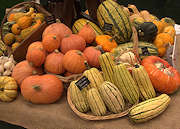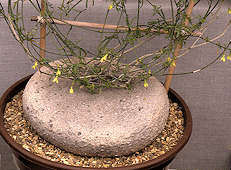 
The Order Cucurbitales contains a group of mainly tropical dicotyledenous flowering herbs and shrubs, with 7 families and 2300 species including the decorative Begoniaceae (1400 species) and Cucurbitaceae (825 species). Members of this order generally have unisexual flowers often with 5-fold symmetry. Members of the Cucurbitaceae generally have tendrils to help them scramble through bushes.
The order takes its name from the genus Cucurbita (squashes, pumpkins) that includes many important food plants (cucumber, melon, pumpkin, squash) as well as useful inedible species (bottle gourds, loofah, ornamental gourds). Members of this family have been cultivated for at least 10,000 years. Some species e.g. Bryonia are also considered to have medicinal properties.
Cucurbitacins (tetracyclic triterpenoids and their glycosides) among the most bitter substances known, are commonly found in this family. Their bitter flavours discourage or even poison herbivores. Cucurbitacins have been investigated as anticancer agents, insecticides and beetle attractants. Most cultivated edible Cucurbitaceae have been selected to produce low levels of Cucurbitacins. The bitterness of cultivated species may increase in response to environmental stress such as heat or shortage of water or after cross pollination from wild plants. The concentration of cucurbitacins is generally highest in roots and fruit. Warty Asian bitter melons are grown especially for this bitter flavour which is prized in certain recipes.
Among the Cucurbitaceae, species of the genera Coccinia, Corallocarpus, Cyclantheropsis,
Gerrardanthus,
Ibervillea,
Kedrostis, Melothria, Momordica, Odosicyos, Seyrigia, Xerosicyos, and Zehneria are generally considered worthy of cultivation as succulent or caudiciform plants.
Begoniaceae are widely grown for decorative effect as freely-flowering housplants and as tender Summer bedding plants. Many species of Begonia have quite succulent stems and tubers, but are not usually shown as succulent plants.
|

 Families of Succulent Plants
Families of Succulent Plants 





